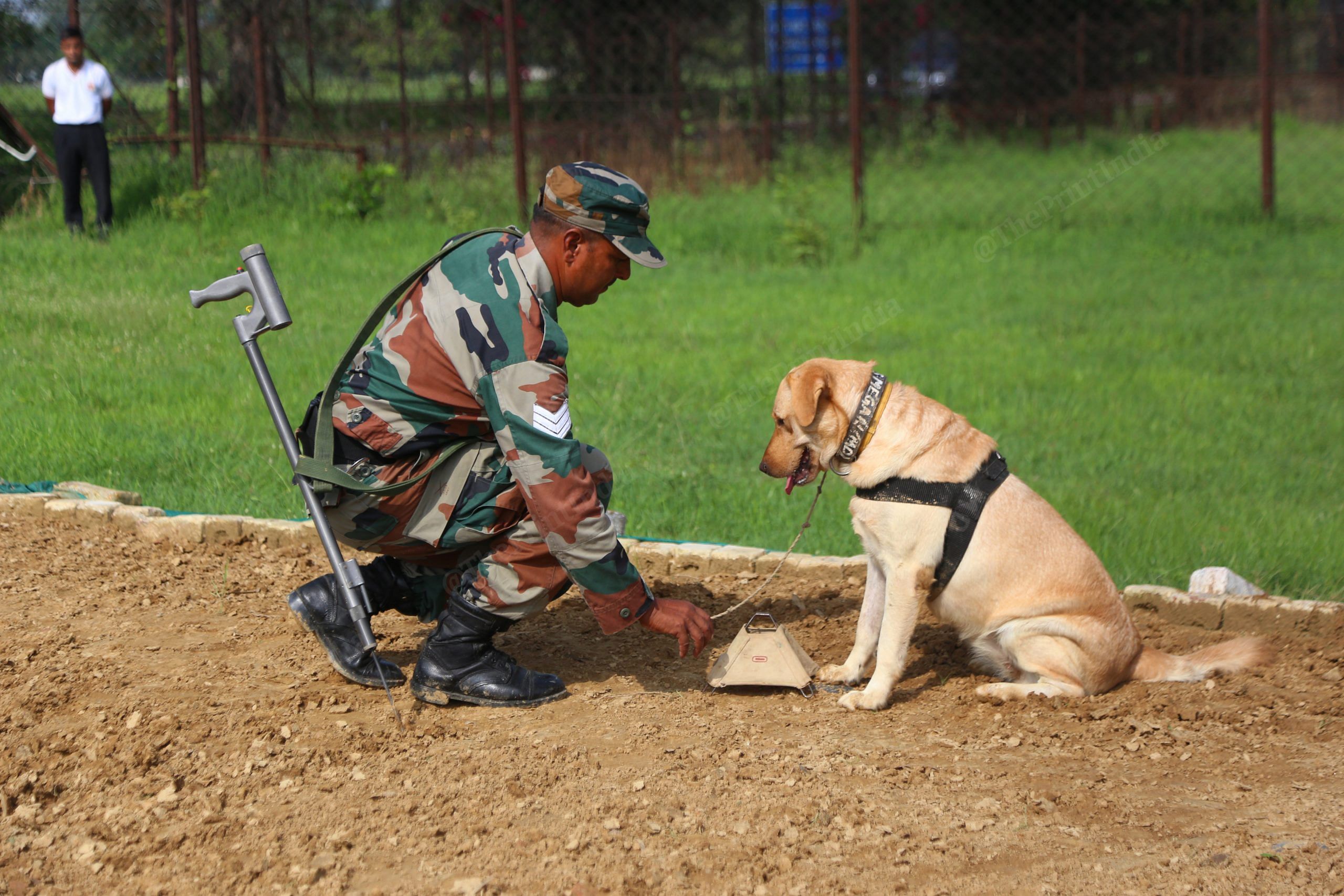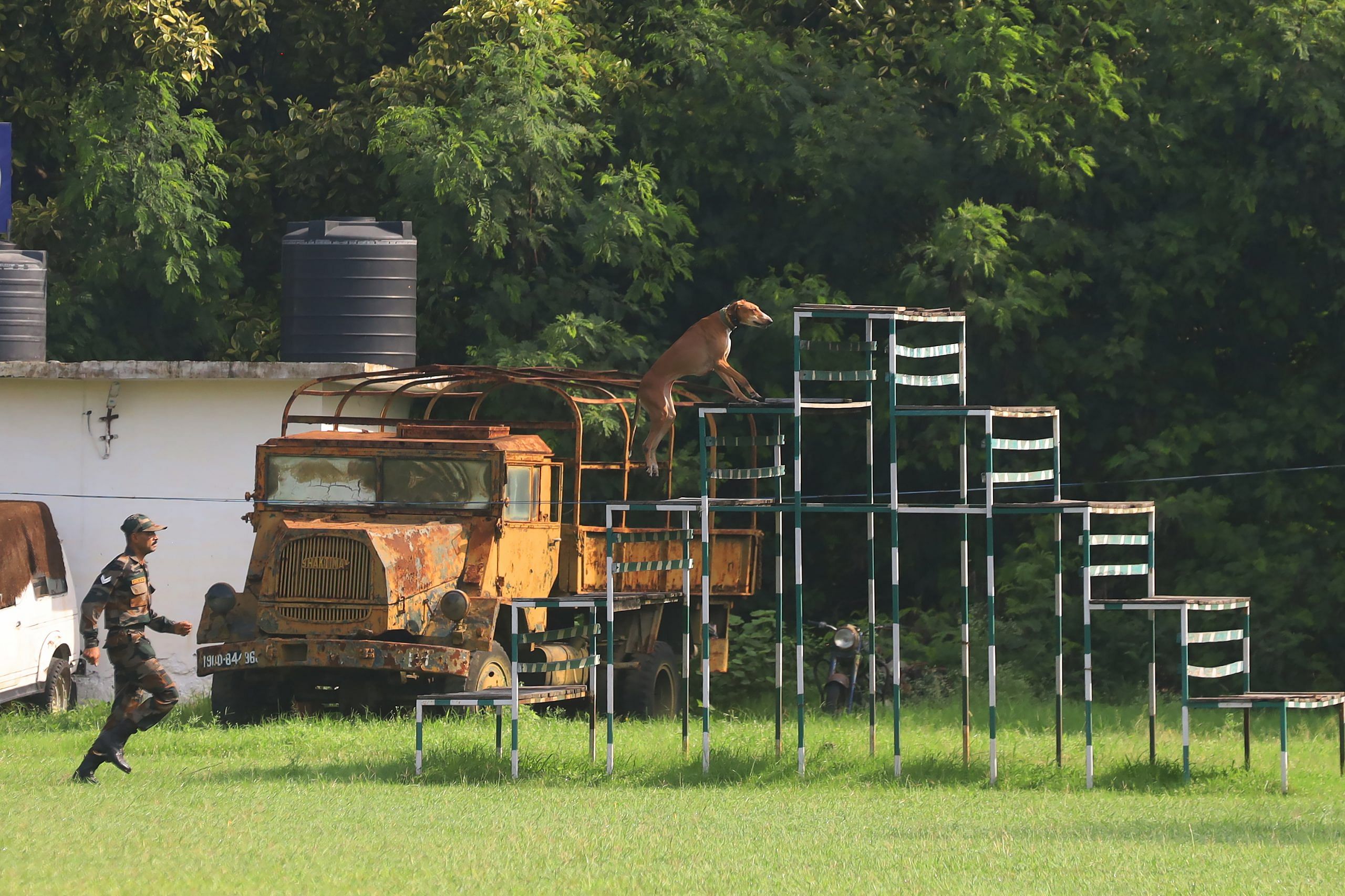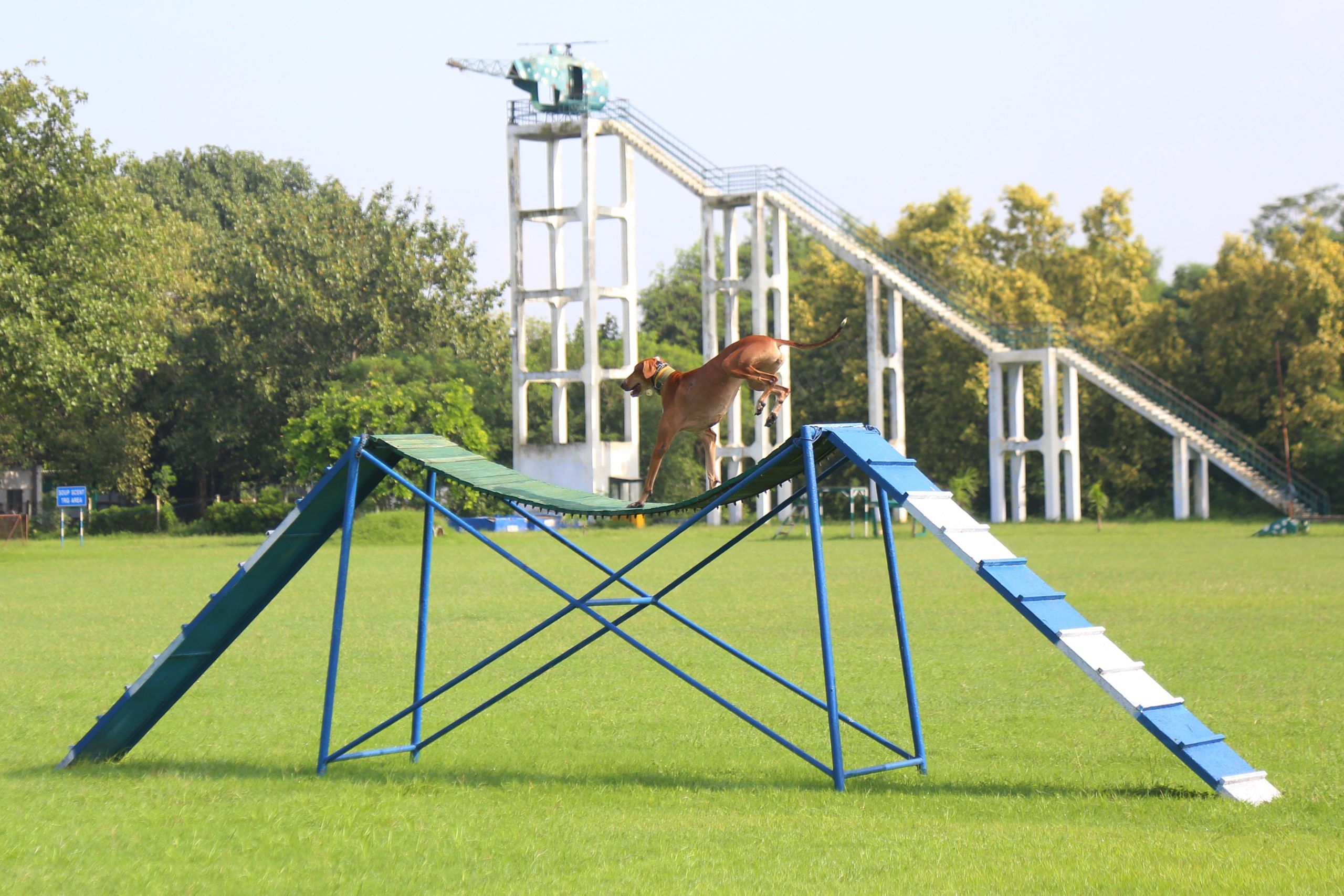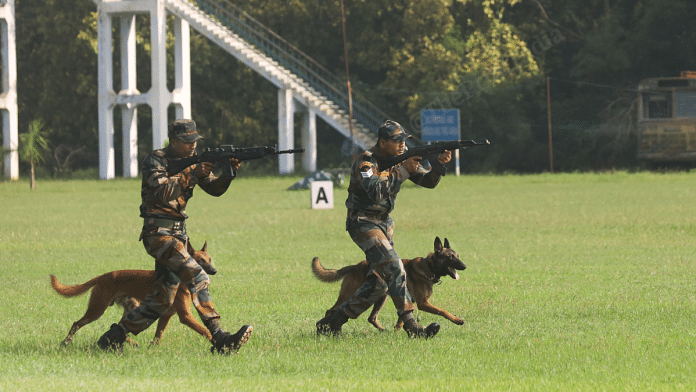Meerut: The Army lost a valued asset in Jammu and Kashmir last month: Axel, an elite assault dog killed in action. It left many in faraway Meerut sad. That’s where his journey had begun.
Axel was one of the hundreds of canine soldiers trained and deployed by the Army at Remount Veterinary Corps Centre (RVC), Meerut. Every trainee dog that graduates goes on to perform an important national duty — against terrorism, narcotics, and natural disasters.
At the heart of all this is the RVC. The centre doesn’t take its job lightly: Just like the National Defence Academy in Pune, the corps puts its trainees through rigorous, regimented instruction. From controlled breeding to a puppy aptitude test, these dogs are groomed to be lethal from the very beginning.
The Indian Army has also gifted canine soldiers to friendly foreign countries, including Sri Lanka, Bangladesh, Nepal, Myanmar, Cambodia, and South Africa. They’ve been such a success that these countries have sent their army personnel to India to train in handling dogs.
Axel, a Belgian Malinois, had just turned two when he passed, spending most of his life at the centre. Like every other dog that graduates, Axel underwent basic obedience training and then specialised assault training.
“We were all so emotional to hear about Axel’s death,” said Major S.K. Barotra, who trains dogs in obedience and tracking squads at the RVC Centre. After Axel graduated, he was posted to the 26 Army Dog Unit and was in operation with the 29 Rashtriya Rifles. His unit gave him a proper sendoff — including a memorial during which other dogs executed a formation. The General Officer Commanding (GOC) of the Kilo Force, the formation that looks after North Kashmir, also placed a wreath along with other officers. Axel also became the first assault dog to be mentioned in the Army’s despatches, commending his bravery in battle.
While Axel’s unit will miss him, work continues as usual at the RVC Centre as the demand for the Army’s canine soldiers outweighs the number of their graduates.
Also read: Army dog ‘Axel’ killed in tense Kashmir operation. Took on terrorist even after he was shot at
A dog-eat-dog demand
The RVC Centre is teeming with dogs, but this isn’t a happy, therapeutic place for playful dogs and their handlers. This is a hard-working dog’s 9-to-5 life.
The training is considered so exclusive and elite that the demand for working dogs is through the roof. And part of the training is the amount of care given to them: The centre prioritises the dogs’ health and wellbeing over meeting the high demand.
Oshin, a labrador, was supposed to be sent to her posting at an external security agency one morning. But her handler noticed her temperature was higher than usual — the centre decided to monitor her and hold off her deployment.
“The demand is always high,” said Major Aman Sood, an instructor at the centre who trains dog squads in mine, explosives, and narcotics detection. “We’re catering to the operational demands of the armed forces, and we’ve also got demand from external agencies.”
Agencies like the paramilitary forces and bodies like state police departments reach out to the centre regularly.
Major Barotra and Major Sood are part of the dog training faculty at the centre, which holds the mandate to breed, rear, and train dogs — as well as train their handlers and conduct courses to upgrade skills. At any given point in time, it is mandated to have over 500 dogs.
Detection dogs are the most popular: Both the Army and external agencies value dogs that are trained to detect explosives, mines, and narcotics. Labradors are the chosen breed for the task — with their highly developed sense of smell, intelligence, and friendly temperament.

Before sending them off on their tasks, the handlers give them their orders. The key part of the instruction is to recognise two words — soongho, dhoondo (smell, search). And the dogs respond with immediate precision.
In one demonstration, a tracker dog named Duke sniffed a rag with a scent on it. The labrador was then led away while the rag was hidden. His handler issued the order: Soongho, dhoondo. Duke walked right up to the rag’s hidden spot and sat in front of it. The drill is called a man-to-article search and used to identify people in real operational scenarios.
Assault dogs like Axel are also quite sought-after. Axel was shot and killed while clearing a room in a Kashmir building. The Belgian Malinois is known for its agility and aggression — so much so that the Army discontinued training them between 2011 and 2018 to study their psychology better.
Besides Labradors and Belgian Malinois, the Army concentrates on training German Shepherds for protection tasks like infantry patrolling and guard duties. The RVC Centre is also currently training a few Cocker Spaniels to detect Covid: Deployed at transit camps, they were able to detect Covid-positive urine and sweat samples.

Indian breeds haven’t been left out either. Indigenous dogs, including the Mudhol Hound, Chippiparai, Kombai, and Rajapalyam, made the cut after 2016 — part of the ‘Make in India’ initiative, according to the Army. The names of all dogs at the centre are either ‘Indian’ or ‘Western’— Kura and Tipsy are two such examples. The only point to remember is that the names should be easily distinguishable from each other — and that each dog is named after their mother’s initials in an ode to their breeding legacy.
Also read: Lucknow’s Brownie going home, but Indians are abandoning breed dogs — tied on roads, bridges
All bark, all bite
Every morning, the dogs go on a 4-5 km run. Their temperatures are taken before they start their first training session of the day. After that, it’s grooming time and meals — this is rinsed and repeated in the evening.
And the dogs have the Army’s attention before they’re even born.
Parents go through a careful selection process — their genetics are carefully examined, semen analyses are conducted, and a software is used to look at the dogs’ pedigrees. Various factors such as litter size, potential hereditary issues, and the performance of previous progeny are evaluated.
The RVC Centre houses several dogs meant just to be bred and carefully tends to them. Treadmills are stationed outside their quarters for them to exercise on, and they have ample space outside their kennels to wander and play when they have free time. The dams—the female breeding dogs—are monitored continuously and given all necessary medical help.
When the pups are born, an elaborate whelping process begins. Led by Major Mittu Kurian, the Army tenderly cares for each newborn, monitoring its traits and temperament.
The pups might be born into care, but they’re inducted into Army life as soon as they are six. The young soldiers are microchipped and have their unit numbers tattooed onto their left ears before they begin their basic training. But one big change is that the Army now uses ‘positive reinforcement’ to train them as opposed to earlier ‘domination’ methods.
Positive reinforcement includes both verbal rewards and treats: After a dog does a good job, the handler awards them with a “shabaash” (well done) or a “good dog”. Food treats range from dog biscuits to more “high-value treats”, which usually include paneer and meat.
At six months, the puppies are put through basic obedience training. Then they take an aptitude test — they’re tested on their ability to retrieve things, follow commands, and practice restraint. They’re also tested on their sensitivity to touch, sight, and sound, and their social attraction and dominance are also evaluated. Handlers evaluate them on a scale, after which they’re sorted into specialised units.

“The aptitude test is important before inducting the dog into a speciality,” said Major Sood. “Based on their performance in the test, we have a fair idea about the dog’s working obedience and whether it will perform well in a certain speciality.” The working obedience of a dog depends on their temperament and aptitude for certain skills. “We’re basically reclassifying the dogs based on their speciality,” he added.
An Army dog can specialise in one of the following, based on their skills: Tracker, guard, mine detection, explosive detection, infantry patrol, avalanche rescue operations, search and rescue, assault and narcotic detection, and now, Covid detection. They’re then trained in cohorts — mine detection and tracking take around 36 weeks to train, while guard dogs and infantry patrol dogs graduate in 12 weeks.
The fully trained soldier is then deployed to its dog unit where it adapts and acclimatises to the terrain and undergoes refresher training. The dog is permanently stationed at its unit until it turns nine years old, after which it can retire.
The geriatric dogs then return to their retirement home in the RVC Centre. They’re pampered and played with here — and made available for adoption. Otherwise, they loll on the grass under the sun, enjoying their rest after an active Army life.
Until 2015, the dogs were euthanised. But the Army changed the rules following an uproar.
Also read: Army sniffer dog, soldier detect explosives on Srinagar-Baramulla highway, save ‘dozens of lives’
A dog’s best friend
Every unit has 24 dogs and 35 handlers, one unit commander, and support staff. The demand for Army dogs is high, but the number of capable handlers is still too low.
The Army has a mandatory dog training course that coaches soldiers on how to deal with canines. It’s an emotional, mental, and physical challenge. The handlers are regularly posted to different dog units to reduce the dogs’ dependency on one specific person — and the handlers’ attachment to a single dog.
But Major Barotra still remembers the first dogs he trained — it was nearly seven years ago, and he has trained hundreds of dogs since, but the first are always special.
“I’ll never forget them. They were a female and a male dog, and I still remember trying to understand their personalities while training them,” said Major Barotra. The trick to crack is identifying the dog’s drive: There’s a ‘food drive,’ ‘play drive’, and ‘prey drive,’ among others.
Of course, there’s emotional attachment. But the Army tries not to anthropomorphise them, according to Major Sood. “Training a dog means opening it up to all its capabilities, not restricting it,” he said.
He remembers the moment when he first trained a dog to perform a trick — something clicked. “From that one single moment, you’re able to understand the psychology of the dog, what it wants from you, and the methodology behind training it. It’s not that easy to get something out of a dog, but now you know that it’s possible — and as a dog trainer you’ve understood how it works,” he added. He commanded a dog unit for three years before moving to the RVC Centre two years ago. Ironically, his family is allergic to dogs.
The dogs, the RVC Centre is sure, couldn’t ask for a better life in preparation for their service. Everything is catered to them — diet to leisure time. In the middle of all this, do the dogs feel the stress and pressure of taking on such national responsibilities?
“Stressed?” asked Major Sood. “Not at all. The dogs don’t have the time to be stressed.”
(Edited by Humra Laeeq)



